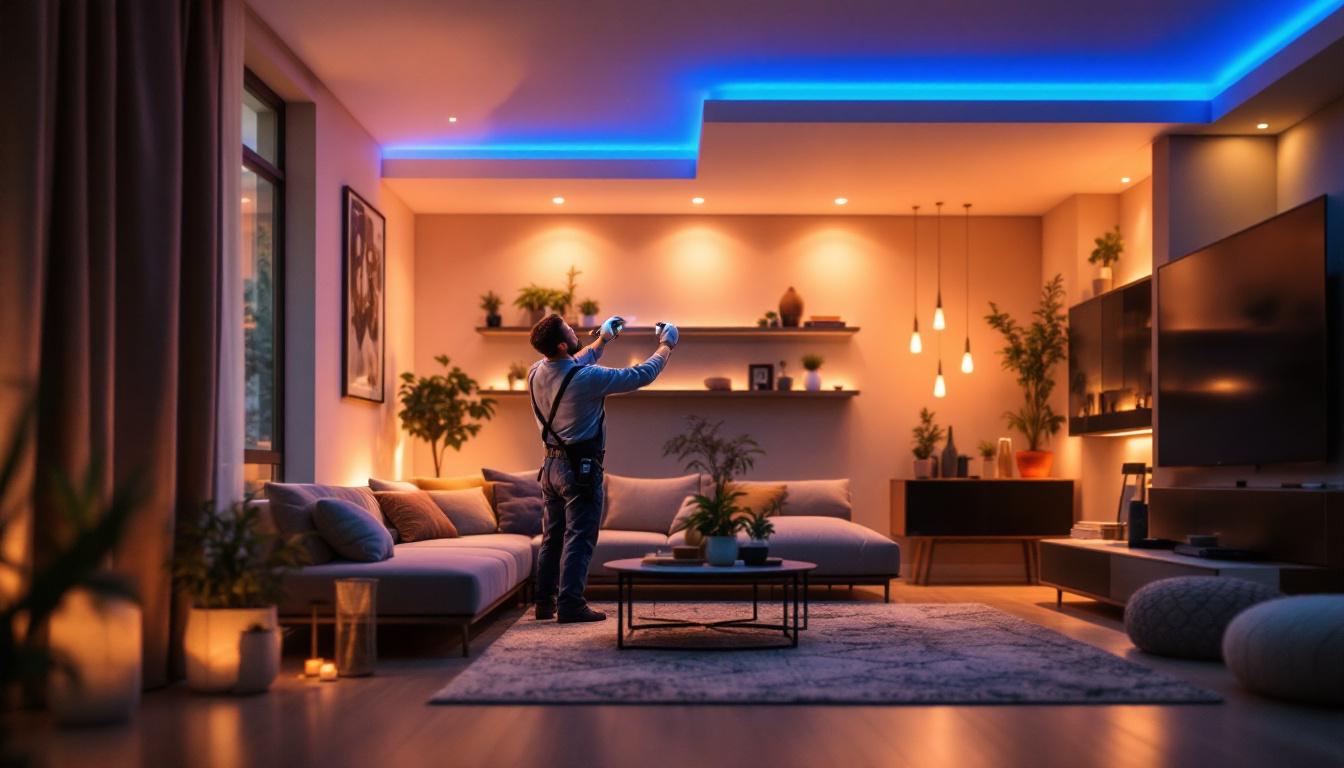
In the evolving landscape of lighting technology, LED bulbs have emerged as a game-changer, particularly for can lights. As a lighting contractor, understanding the nuances of LED bulbs is essential for providing clients with optimal solutions. This article delves into the key points regarding LED bulbs for can lights, focusing on their benefits, installation considerations, and performance metrics.
LED, or Light Emitting Diode, technology has revolutionized the way we illuminate spaces. Unlike traditional incandescent or fluorescent bulbs, LED bulbs convert electricity directly into light, resulting in higher efficiency and lower energy consumption. This shift not only improves the performance of lighting systems but also aligns with the growing demand for sustainable energy solutions in both residential and commercial sectors.
One of the most significant advantages of LED technology is its longevity. LED bulbs can last up to 25,000 hours or more, significantly reducing the frequency of replacements. This longevity not only translates to cost savings for clients but also minimizes waste, making LED bulbs an environmentally friendly choice. Furthermore, the durability of LEDs means they are less prone to breakage compared to fragile incandescent bulbs, which can be particularly beneficial in high-traffic areas or outdoor settings where lighting fixtures may be exposed to the elements.
Energy efficiency is one of the primary selling points of LED bulbs. They consume significantly less power than traditional bulbs, which can lead to substantial savings on electricity bills. For lighting contractors, this efficiency can be a compelling argument when discussing options with clients. In fact, many utility companies offer rebates or incentives for switching to LED technology, further enhancing the financial appeal for consumers looking to upgrade their lighting systems.
Moreover, LED bulbs produce less heat compared to incandescent bulbs. This characteristic not only enhances safety but also contributes to energy savings as less energy is wasted as heat. In commercial settings, this can lead to lower cooling costs, making LED bulbs an attractive option for businesses. The reduced thermal output also means that HVAC systems can operate more efficiently, which is an important consideration for large facilities aiming to optimize their energy consumption and overall operational costs.
Another critical aspect of LED bulbs is their versatility in color temperature. They are available in a range of color temperatures, from warm white to cool daylight, allowing contractors to tailor lighting solutions to specific needs. This flexibility is particularly important in residential applications, where ambiance plays a significant role in client satisfaction. For example, warm white LEDs can create a cozy atmosphere in living rooms and bedrooms, while cooler daylight options are ideal for workspaces that require focus and concentration.
Additionally, the quality of light produced by LED bulbs is often superior to that of traditional bulbs. LEDs provide consistent illumination without flickering, which can enhance the overall aesthetic of a space. For contractors, being able to offer high-quality lighting can set them apart in a competitive market. Furthermore, advancements in LED technology have led to the development of tunable white LEDs, which allow users to adjust the color temperature throughout the day, mimicking natural light patterns and supporting circadian rhythms. This innovative feature not only improves the well-being of occupants but also demonstrates the contractor’s commitment to providing cutting-edge solutions that prioritize health and comfort in lighting design.
While LED bulbs offer numerous advantages, their installation requires careful consideration. Understanding the specific requirements for can lights is essential for ensuring optimal performance and client satisfaction.
One of the first steps in the installation process is ensuring compatibility with existing fixtures. Not all can lights are designed to accommodate LED bulbs, and using incompatible fixtures can lead to performance issues or even damage to the bulb. It’s crucial to verify the specifications of both the fixture and the LED bulb before proceeding with installation.
Many clients prefer dimmable lighting for added versatility, making dimmer compatibility an essential factor to consider. Not all LED bulbs are compatible with standard dimmer switches, which can lead to flickering or buzzing noises. Contractors should recommend LED bulbs specifically designed for dimming applications and ensure that the dimmer switch is also compatible with LED technology.
When selecting dimmers, it is advisable to opt for those that are labeled as “LED compatible.” This will help prevent potential issues and ensure a smooth user experience for clients. Educating clients about the importance of using compatible dimmers can also enhance their overall satisfaction with the lighting solution.
Heat management is another critical consideration during installation. While LEDs generate less heat than traditional bulbs, they still produce some heat that needs to be dissipated effectively. Proper ventilation within the can light fixture is essential to prevent overheating, which can shorten the lifespan of the bulb.
Contractors should assess the design of the can light and ensure that it allows for adequate airflow. In some cases, it may be necessary to recommend fixtures specifically designed for LED use, which often feature better heat dissipation capabilities. This proactive approach can help avoid future issues and enhance client satisfaction.
When recommending LED bulbs for can lights, it is essential to understand and communicate the relevant performance metrics. These metrics can help clients make informed decisions and ensure that the chosen lighting solution meets their needs.
Luminous efficacy, measured in lumens per watt, is a critical metric for evaluating the efficiency of a light source. LED bulbs typically offer higher luminous efficacy compared to traditional bulbs, meaning they produce more light while consuming less energy. This efficiency can be a significant selling point for contractors when discussing options with clients.
For instance, an LED bulb that produces 800 lumens while consuming only 10 watts is far more efficient than an incandescent bulb that requires 60 watts to achieve the same light output. Highlighting these figures can help clients understand the long-term benefits of investing in LED technology.
The Color Rendering Index (CRI) is another important performance metric that measures a light source’s ability to accurately render colors compared to natural light. A higher CRI indicates better color accuracy, which is particularly important in settings where color perception is critical, such as art galleries or retail environments.
Most quality LED bulbs have a CRI of 80 or higher, making them suitable for a wide range of applications. Contractors should consider the CRI when recommending LED bulbs, especially for clients who prioritize color accuracy in their lighting solutions.
While the initial cost of LED bulbs may be higher than traditional options, the long-term savings often outweigh this upfront investment. For lighting contractors, it is vital to communicate the total cost of ownership to clients, which includes not only the purchase price but also energy savings and reduced maintenance costs.
Calculating the return on investment (ROI) for LED bulbs can help clients see the value in their purchase. For example, by comparing the energy consumption and lifespan of LED bulbs versus incandescent or fluorescent options, contractors can provide clients with a clear picture of potential savings over time.
Many regions offer incentives or rebates for upgrading to energy-efficient lighting solutions, including LED bulbs. Contractors should stay informed about available programs in their area and communicate these opportunities to clients. This information can further enhance the appeal of LED technology and make the transition more financially feasible for clients.
By leveraging these incentives, contractors can not only help clients save money but also promote energy-efficient practices that contribute to sustainability goals. This proactive approach can enhance a contractor’s reputation as a knowledgeable and responsible professional in the lighting industry.
Educating clients about LED technology and its benefits is crucial for ensuring satisfaction and fostering long-term relationships. Lighting contractors should take the time to explain the advantages of LED bulbs, installation considerations, and performance metrics to help clients make informed decisions.
Providing ongoing support and resources can also enhance the client experience. This could include offering maintenance tips, guidance on bulb replacement, or information on new lighting technologies as they emerge. By positioning themselves as trusted advisors, contractors can build loyalty and encourage repeat business.
Demonstrating the value of LED bulbs in can lights can be achieved through various means. For instance, showcasing case studies or testimonials from satisfied clients can help illustrate the benefits of LED technology in real-world applications. Additionally, providing samples or demonstrations can allow clients to experience the quality of light firsthand.
Contractors can also leverage digital platforms to share educational content, such as blog posts, videos, or infographics that highlight the advantages of LED technology. This approach not only informs clients but also positions the contractor as an authority in the field, ultimately leading to increased trust and business opportunities.
In summary, LED bulbs for can lights represent a significant advancement in lighting technology, offering numerous benefits for both contractors and clients. Understanding the intricacies of LED technology, installation considerations, performance metrics, and cost implications is essential for lighting contractors aiming to provide exceptional service.
By staying informed about the latest developments in LED technology and effectively communicating these insights to clients, contractors can position themselves as industry leaders. The transition to LED lighting not only enhances energy efficiency and reduces costs but also contributes to a more sustainable future.
As the demand for energy-efficient lighting solutions continues to grow, lighting contractors who embrace LED technology will be well-equipped to meet the needs of their clients and thrive in a competitive market.
Ready to elevate your lighting game and provide your clients with the best in LED technology? Look no further than LumenWholesale. Our commitment to empowering contractors like you with spec-grade lighting products at unbeatable wholesale prices ensures your projects shine without breaking the bank. With our extensive selection that meets the highest industry standards, you can trust in the reliability and performance of our lighting solutions. Plus, with free shipping on bulk orders, you can enjoy premium lighting at the best value — all without hidden fees or compromises. Don’t miss out on the perfect blend of quality, affordability, and convenience. Wholesale Lighting at the Best Value is just a click away.

Explore how innovative lighting solutions for walkways can enhance energy efficiency, reduce costs, and improve safety.

Discover why wall plug outlets are crucial for lighting contractors in optimizing electrical installations.

Discover why purchasing vapor tight lighting in bulk from local distributors might not be the best choice.

Discover the comprehensive guide to home LED lights tailored for lighting contractors.